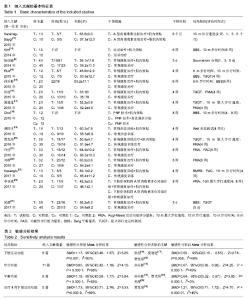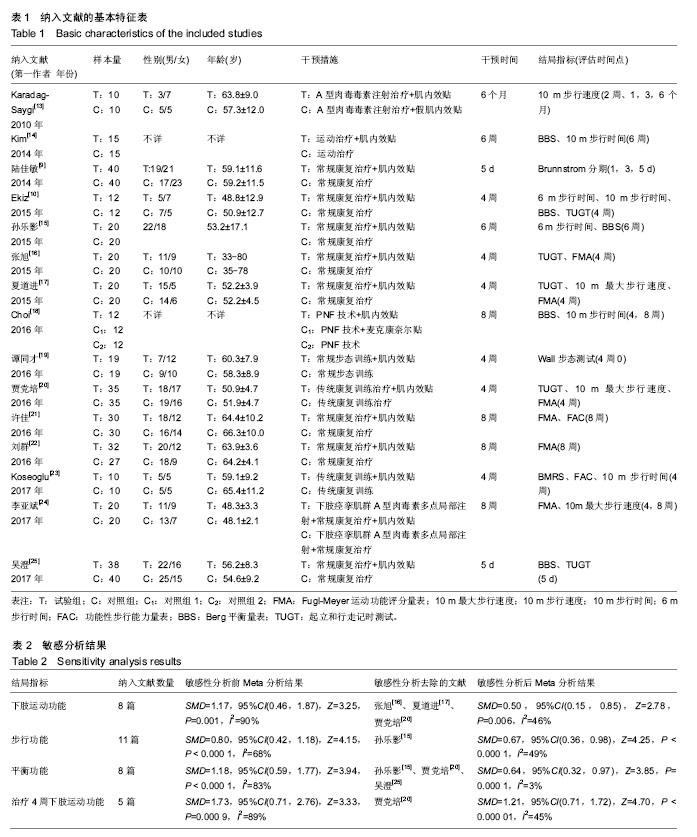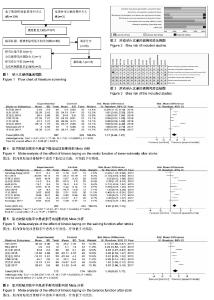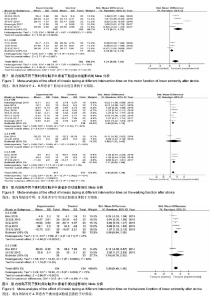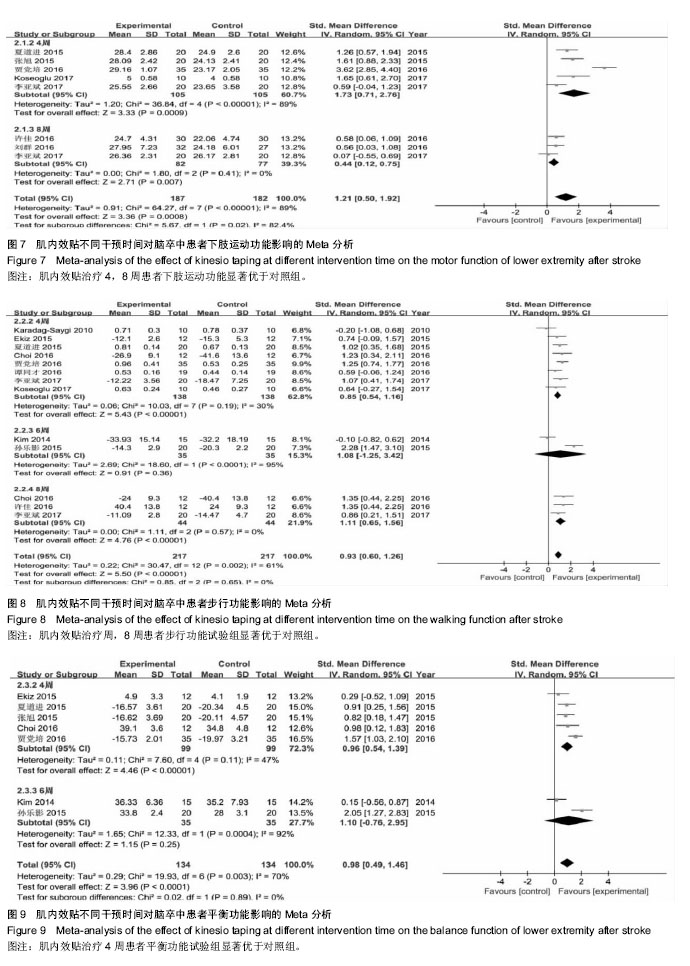Chinese Journal of Tissue Engineering Research ›› 2018, Vol. 22 ›› Issue (32): 5241-5248.doi: 10.3969/j.issn.2095-4344.0400
Effects of kinesio taping at different intervention time on the motor function of lower extremity after stroke: a Meta-analysis
Wu Yan-hua, Li Zhuang-miao, Dong Xu
- Fujian University of Traditional Chinese Medicine, Fuzhou 350122, Fujian Province, China
-
Received:2018-07-09Online:2018-11-18Published:2018-11-18 -
Contact:Li Zhuang-miao, Master, Associate professor, Fujian University of Traditional Chinese Medicine, Fuzhou 350122, Fujian Province, China -
About author:Wu Yan-hua, Master candidate, Fujian University of Traditional Chinese Medicine, Fuzhou 350122, Fujian Province, China -
Supported by:the Young Elite Cultivation Program of Fujian Provincial Health and Family Planning Commission, No. 2017-ZQN-64
CLC Number:
Cite this article
Wu Yan-hua, Li Zhuang-miao, Dong Xu. Effects of kinesio taping at different intervention time on the motor function of lower extremity after stroke: a Meta-analysis[J]. Chinese Journal of Tissue Engineering Research, 2018, 22(32): 5241-5248.
share this article
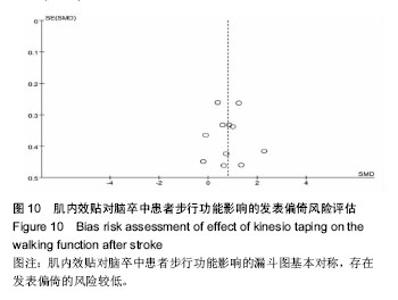
2.1 文献检索结果 初步检出文献共312篇,最终纳入15个随机对照试验[9-10,13-25],共675例患者。纳入文献筛选流程见图1,纳入文献的基本特征见表1。 2.2 纳入文献的方法学质量评价 纳入15篇文献 中[9-10,13-25],5篇文献描述使用随机数字表法进行随机分 组[9,16-17,22,24],1篇文献描述使用信封进行随机分组[20];所有纳入文献均未对分配隐藏方案进行描述;2篇文献对研究者和受试者施盲[13,18],1篇文献未对研究者和受试者施盲[9],且其结局可能受盲法缺失的影响;3篇文献对结局指标评价实施盲法[13,17,24],1篇文献未对结局指标评价实施盲法[18],且结局的测量可能受盲法缺失的影响;11篇文献结果数据完整[9,13,15-17,19-24],2篇文献未提及结果数据完整性问题[10,18],2篇文献有脱落失访病例[13,25],但原因及处理方式未报道;所有纳入文献均未发现选择性报道结果;所有纳入文献的基线资料均具有可比性,1篇文献存在于使用的研究设计方案相关的偏倚[13],其余文献无其他偏倚来源或不清楚。具体偏倚风险评估见图2,3。 2.3 Meta分析结果 通过异质性检验发现各研究间存在异质性(P ≤ 0.1或I2 ≥ 50%)且结局指标评价采用不同评价量表,故以标准化均数差(SMD)作为效应量,采用随机效应模型进行Meta分析,并对不同干预时间行亚组分析。 2.3.1 肌内效贴对脑卒中患者下肢运动功能影响的Meta分析 共纳入8篇文献[9,16-17,20-24],其中6篇采用FMA下肢部分[16-17,20-22,24]、2篇采用下肢Brunnstrom运动功能分期评价[9,23]。Meta分析结果显示,肌内效贴能改善脑卒中患者下肢运动功能,疗效优于对照组,差异具有统计学意义[SMD=1.17,95%CI(0.46,1.87),Z=3.25,P=0.001,I2=90%]。见图4。 2.3.2 肌内效贴对脑卒中患者步行功能影响的Meta分析共纳入11篇文献[10,13-15,17-21,23-24],其中3篇评估10 m最大步行速度[17,20,24]、1篇评估10 m步行速度[13]、4篇评估10 m步行时间[10,13,18,23]、1篇评估6 m步行时间[15]、1篇参照Wall的步态测试方法评估步速[19]、1篇评估FAC[21]。Meta分析结果显示,肌内效贴能改善脑卒中患者步行功能,疗效优于对照组,差异有统计学意义[SMD=0.80,95%CI (0.42,1.18),Z=4.15,P < 0.000 1,I2=68%]。见图5。 2.3.3 肌内效贴对脑卒中患者平衡功能影响的Meta分析共纳入8篇文献[10,14-18,20,25],其中5篇采用BBS进行评 估[10,14-15,18,25]、3篇评估TUGT[16-17,20]。Meta分析结果显示,肌内效贴能改善脑卒中患者平衡功能,疗效优于对照组,差异具有统计学意义[SMD=1.18,95%CI(0.59,1.77,Z=3.94,P < 0.000 1,I2=83%]。见图6。 2.3.4 肌内效贴对脑卒中患者下肢运动、步行和平衡功能影响的亚组分析 (1)肌内效贴不同干预时间对脑卒中患者下肢运动功能影响的Meta分析:5篇文献报道了治疗4周的结 果[16-17,20,23-24],亚组分析结果显示,两组差异有统计学意义[SMD=1.73,95%CI(0.71,2.76),Z=3.33,P=0.000 9,I2=89%];3篇文献报道了治疗8周的结果[21-22,24],亚组分析结果显示,两组差异有统计学意义[SMD=0.44,95%CI (0.12,0.75),Z=2.71,P=0.007,I2=0%]。见图7。 (2)肌内效贴不同干预时间对脑卒中患者步行功能影响的Meta分析:8篇文献报道了治疗4周的结果[10,13,17-20,23-24],亚组分析结果显示,两组差异有统计学意义[SMD=0.85,95%CI(0.54,1.16),Z=5.43,P < 0.000 01,I2=30%]; 2篇文献报道了治疗6周的结果[14-15],亚组分析结果显示,两组差异无统计学意义[SMD=1.08,95%CI(-1.25,3.42),Z=0.91,P=0.36,I2=95%];3篇文献报道了治疗8周的结 果[18,21,24],亚组分析结果显示,两组差异有统计学意义[SMD=1.11,95%CI(0.65,1.56),Z=4.76,P < 0.000 01,I2=0%]。见图8。 (3)肌内效贴不同干预时间对脑卒中患者平衡功能影响的Meta分析:5篇文献报道了治疗4周的结果[10,16-18,20],亚组分析结果显示,两组差异有统计学意义[SMD=0.96,95%CI(0.54,1.39),Z=4.46,P < 0.000 01,I2=47%];2篇文献报道治疗6周的结果[14-15],亚组分析结果显示,两组差异无统计学意义[SMD=1.10,95%CI(-0.76,2.95),Z=1.15,P=0.25,I2=95%]。见图9。 2.3.5 敏感性分析 纳入的部分研究间存在统计学异质性(P ≤ 0.1或I2 ≥ 50%),故对纳入≥3篇文献的组别通过逐篇去除文献进行敏感性分析,探索其异质性来源及其结果的稳定性。虽然去除部分研究可使异质性检验结果I2值发生质的改变(P < 0.01或I2 < 50%),但均未对Meta分析结果产生本质性的改变,差异仍有统计学意义(P < 0.05),与敏感性分析前的Meta分析结果一致,说明研究分析结果相对稳定,具体敏感性分析结果见表2。 2.3.6 发表偏倚风险评估 绘制漏斗图评估肌内效贴对脑卒中患者步行功能(纳入11篇文献)影响的发表偏倚,结果显示肌内效贴对脑卒中患者步行功能影响的漏斗图基本对称(图10),存在发表偏倚的风险较低。"
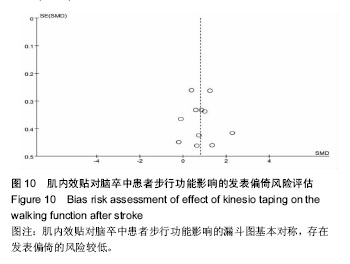
| [1] 中华医学会神经病学分会.中国脑卒中早期康复治疗指南[J].中华神经科杂志,2017,50(6):405-412.[2] 刘俊英,贾亮,王贵玲,等.强化早期步行训练在脑卒中重度偏瘫患者肢体康复护理中的应用[J].实用临床医药杂志, 2017,21(16):120-122.[3] 祁奇,王予彬,陈文华,等.肌内效贴在运动损伤康复中的应用进展[J].中国康复医学杂志,2013,28(10):971-974.[4] BoeskovB,CarverLT,Essen-LeiseAV,et al.Kinesthetic Taping Improves Walking Function in Patients with Stroke:A Pilot Cohort Study.Top Stroke Rehabil.2014;21(6):495-501.[5] Lee YJ,KimJY,KimSY,etal.The effects of trunk kinesio taping on balance ability and gait functioninstrokepatients. J Phys Ther Sci. 2016;28(8):2385-2388.[6] Yang SR,HeoSY,Lee H J.Immediate effects of kinesio taping on fixed postural alignment andfootbalance in stroke patients.J Phys Ther Sci. 2015;27(11):3537-3540.[7] Yazici G,Guclugunduz A,Bayraktar D,et al.Does correcting position and increasing sensorial inputof the foot and ankle with Kinesio Taping improve balance in stroke patients? Neuro Rehabil. 2015;36(3): 345-353.[8] Park YH,Lee JH.Effects of proprioceptive sense-based Kinesio taping on walking imbalance.JPhysTher Sci.2016;28(11):3060-3062.[9] 陆佳敏,高天昊,贾杰,等.肌内效贴贴扎治疗对脑卒中后下肢功能的影响[J].中国康复医学杂志,2014,29(12):1165-1167.[10] Ekiz T,Aslan MD,Özgirgin N.Effects of Kinesio Tape application to quadriceps muscles on isokinetic muscle strength,gait,and functional parameters in patients with stroke.J Rehabil Res Dev. 2015;52(3): 323-3231.[11] BaeYH,Kim HG,Min KS,et al.Effects of lower-leg kinesiology taping on balance ability instroke patients with foot drop[2015-10-22]. http://dx.doi.org/10.1155/2015/125629.[12] Benjamin D,Stela H,Iztok H.Estimating the mean and variance from the median,range,and the size of a sample.BMC Med Res Methodol. 2005;5(1):13-23.[13] Karadag-Saygi E,Cubukcuaydoseli K,Kablan N,et al.The role of kinesiotaping combined with botulinum toxin to reduce plantar flexors spasticity after stroke.Top Stroke Rehabil.2010;17(4):318-322.[14] Kim WI,ChoiYK,LeeJH,etal.The effect of muscle facilitation using kinesio taping on walkingand balance of stroke patients.JPhysTher Sci. 2014;26(11):1831-1834.[15] 孙乐影,高修明,孙楠,等.不同肌内效贴法在脑卒中后偏瘫患者足下垂中的临床观察[J].医学信息, 2015,28(8):104-105.[16] 张旭,都丽丽,赵波,等.肌内效贴治疗脑卒中偏瘫患者步行功能障碍的疗效观察[J].医学信息,2015, 28(47):81-82.[17] 夏道进,彭涛,魏海棠,等.下肢肌内效贴对脑卒中偏瘫患者步行功能的影响[J].中华物理医学与康复杂志,2015,37(6):427-429.[18] Choi YK,ParkYH,Lee JH.Effects of Kinesio taping and Mcconnell taping on balance and walking speed of hemiplegia patients.J Phys Ther Sci. 2016;28(4):1166-1169.[19] 谭同才,叶祥明,余艳梅,等.肌内效贴布对脑卒中偏瘫患者步态的影响研究[J].中国康复医学杂志, 2016,31(6):686-688.[20] 贾党培,李莉,仵志强,等.下肢肌内效贴对改善脑卒中偏瘫患者步行功能的效果分析[J].中国医疗设备,2016,31(s1):80.[21] 许佳,胡世红,周亚飞,等.肌内效贴结合常规运动疗法对偏瘫患者下肢功能及步态的疗效观察[J].中国康复,2016,31(6):446-449.[22] 刘群,余波,祁奇,等.肌内效贴治疗脑卒中患者膝关节不稳及退化的临床疗效观察[J].老年医学与保健,2016,22(5):303-305.[23] Koseoglu BF,Dogan A,Tatli HU,et al.Cankinesio tape be used as an ankle training method in the rehabilitation of the stroke patients?. ComplementTherClin Pract,2017,27:46-51.[24] 李亚斌,冯海霞,梁学镖,等.肌内效贴联合A型肉毒素局部注射和常规康复训练对脑卒中后下肢痉挛患者步行能力的影响[J].中华物理医学与康复杂志,2017,39(8):598-601.[25] 吴澄,朱玉连,刘强,等.肌内效贴辅助下肢训练对脑卒中偏瘫患者下肢运动功能的影响研究[J].中国康复,2017,32(2):131-132.[26] Choi YK,Nam CW,Lee JH,et al.The Effects of Taping Prior to PNF Treatment on Lower Extremity Proprioception of Hemiplegic Patients. JPhysTher Sci.2013;25(9):1119-1122.[27] Kim EB,KimYD.Effects of kinesiology taping on the upper-extremity function and activitiesof daily living in patients with hemiplegia. J Phys Ther Sci.2015;27(5):1455-1457.[28] 刘群,田强,余波,等.肌内效贴配合功能训练改善脑卒中患者下肢功能状况的疗效观察[J].老年医学与保健,2015,21(5):284-286.[29] Balki S,Gökta? HE,Öztemur Z.Kinesio taping as a treatment method in the acute phase of ACL reconstruction:A double-blind, placebo-controlled study.ActaOrthopTraumatol Turc.2016;50(6):628-634.[30] Chang HY,Chou KY,Lin JJ, et al.Immediate effect of forearm Kinesio taping on maximal grip strength and force sense in healthy collegiate athletes.PhysTher Sport.2010;11(4):122-127.[31] Parreira PDCS, Costa LDCM, Junior LCH, et al.Current evidence does not support the use of Kinesio Taping in clinical practice:a systematic review.J Physiother.2014;60(1):31-39.[32] Williams S, Whatman C, Hume PA, et al.Kinesio Taping in Treatment and Prevention of Sports Injuries. Sports Med.2012;42(2):153-164.[33] Lim ECW, Tay MGX. Kinesio taping in musculoskeletal pain and disability that lasts for more than 4 weeks:is it time to peel off the tape and throw it out with the sweat?A systematic review with meta-analysis focused on pain and also methods of tape application.Br J Sports Med. 2015,49(24):1-10.[34] Kalron A,Bar-Sela S.A systematic review of the effectiveness of Kinesio Taping-fact or fashion?.Eur J Phys Rehab Med.2013;49(5): 699-709. [35] Morris D,Jones D,Ryan H,et al.The clinical effects of Kinesio®Tex taping: A systematic review. Physiother Theory Pract.2013;29(4): 259-270. |
| [1] | Zhang Tongtong, Wang Zhonghua, Wen Jie, Song Yuxin, Liu Lin. Application of three-dimensional printing model in surgical resection and reconstruction of cervical tumor [J]. Chinese Journal of Tissue Engineering Research, 2021, 25(9): 1335-1339. |
| [2] | Yuan Mei, Zhang Xinxin, Guo Yisha, Bi Xia. Diagnostic potential of circulating microRNA in vascular cognitive impairment [J]. Chinese Journal of Tissue Engineering Research, 2021, 25(8): 1299-1304. |
| [3] | Zeng Yanhua, Hao Yanlei. In vitro culture and purification of Schwann cells: a systematic review [J]. Chinese Journal of Tissue Engineering Research, 2021, 25(7): 1135-1141. |
| [4] | Wang Jiangna, Zheng Huifen, Sun Wei. Changes in dynamic stability, motor coordination and joint mechanics of the lower extremity during stair descent and performing phone task [J]. Chinese Journal of Tissue Engineering Research, 2021, 25(6): 837-843. |
| [5] | Xu Dongzi, Zhang Ting, Ouyang Zhaolian. The global competitive situation of cardiac tissue engineering based on patent analysis [J]. Chinese Journal of Tissue Engineering Research, 2021, 25(5): 807-812. |
| [6] | Wu Zijian, Hu Zhaoduan, Xie Youqiong, Wang Feng, Li Jia, Li Bocun, Cai Guowei, Peng Rui. Three-dimensional printing technology and bone tissue engineering research: literature metrology and visual analysis of research hotspots [J]. Chinese Journal of Tissue Engineering Research, 2021, 25(4): 564-569. |
| [7] | Chang Wenliao, Zhao Jie, Sun Xiaoliang, Wang Kun, Wu Guofeng, Zhou Jian, Li Shuxiang, Sun Han. Material selection, theoretical design and biomimetic function of artificial periosteum [J]. Chinese Journal of Tissue Engineering Research, 2021, 25(4): 600-606. |
| [8] | Liu Fei, Cui Yutao, Liu He. Advantages and problems of local antibiotic delivery system in the treatment of osteomyelitis [J]. Chinese Journal of Tissue Engineering Research, 2021, 25(4): 614-620. |
| [9] | Li Xiaozhuang, Duan Hao, Wang Weizhou, Tang Zhihong, Wang Yanghao, He Fei. Application of bone tissue engineering materials in the treatment of bone defect diseases in vivo [J]. Chinese Journal of Tissue Engineering Research, 2021, 25(4): 626-631. |
| [10] | Zhang Zhenkun, Li Zhe, Li Ya, Wang Yingying, Wang Yaping, Zhou Xinkui, Ma Shanshan, Guan Fangxia. Application of alginate based hydrogels/dressings in wound healing: sustained, dynamic and sequential release [J]. Chinese Journal of Tissue Engineering Research, 2021, 25(4): 638-643. |
| [11] | Chen Jiana, Qiu Yanling, Nie Minhai, Liu Xuqian. Tissue engineering scaffolds in repairing oral and maxillofacial soft tissue defects [J]. Chinese Journal of Tissue Engineering Research, 2021, 25(4): 644-650. |
| [12] | Xing Hao, Zhang Yonghong, Wang Dong. Advantages and disadvantages of repairing large-segment bone defect [J]. Chinese Journal of Tissue Engineering Research, 2021, 25(3): 426-430. |
| [13] | Huang Maomao, Hu Yue, Wang Binchuan, Zhang Chi, Xie Yujie, Wang Jianxiong, Wang Li, Xu Fangyuan. Bibliometric and visual analysis of international literature addressing ischemic stroke rehabilitation in recent 10 years [J]. Chinese Journal of Tissue Engineering Research, 2021, 25(23): 3725-3733. |
| [14] | Zhu Rui, Zeng Qing, Huang Guozhi. Ferroptosis and stroke [J]. Chinese Journal of Tissue Engineering Research, 2021, 25(23): 3734-3739. |
| [15] | Chen Siqi, Xian Debin, Xu Rongsheng, Qin Zhongjie, Zhang Lei, Xia Delin. Effects of bone marrow mesenchymal stem cells and human umbilical vein endothelial cells combined with hydroxyapatite-tricalcium phosphate scaffolds on early angiogenesis in skull defect repair in rats [J]. Chinese Journal of Tissue Engineering Research, 2021, 25(22): 3458-3465. |
| Viewed | ||||||
|
Full text |
|
|||||
|
Abstract |
|
|||||
